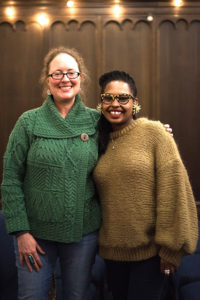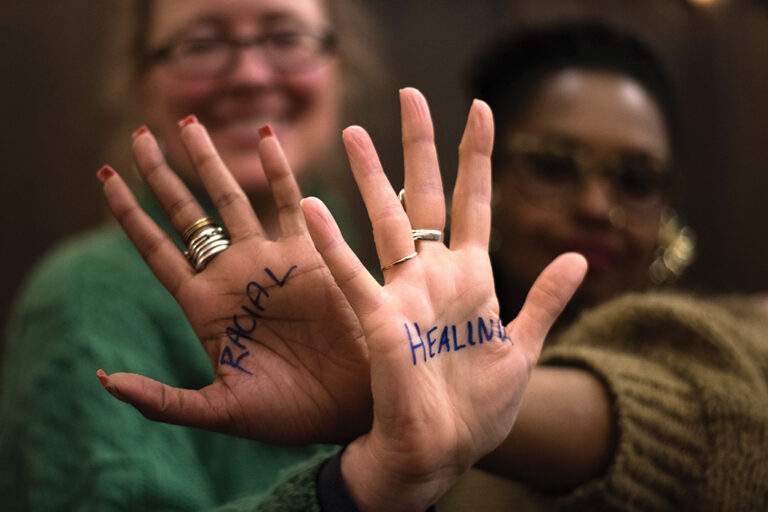When the truth enters our heart, we have to let it wreak havoc on our soul,” one participant shared in Berea College’s new faculty and staff Collaborative Racial Healing Learning Community.
The learning community’s 12 members met nine times during the fall 2017 semester to delve into the topics
of belonging, inclusive excellence and learning. With a grant from the Andrew W. Mellon Foundation, Women and Gender Studies Professor Dr. Qrescent Mason began putting together the idea for a group to discuss racial healing and what it would look like on Berea’s campus.
“I don’t like talking about healing—it’s squishy and difficult,” Mason said about the group’s intense work. “But healing in the context of what Berea is and what people do is valuable.”
Mason was introduced to the topic of racial healing while attending the 2017 Diversity, Learning and Student Success conference hosted by the American Association of Colleges and Universities last March. She attended a W. K. Kellogg Foundation presentation about its recent Truth, Racial Healing and Transformation (TRHT) initiative. The Kellogg project seeks to unearth and jettison the deeply held and often unconscious beliefs created by racism—the main one being the belief in a hierarchy of human value.
That idea of dialogue across race interested Mason. So when Kellogg made a call for grant proposals for the TRHT program this past summer, Mason worked with Dr. Linda Strong-Leek, vice president of diversity and inclusion; Chad Berry, academic vice president and dean of faculty; and Leslie Ortquist-Ahrens, director of the Center for Teaching and Learning to prepare a proposal.
“We had problems getting the proposal done because what it was asking us to do was look forward,” Mason said. “Most of the things we were saying were what Berea has done. We really hadn’t thought forward, so we didn’t end up applying for the grant.”

However, in June the College was awarded a Mellon grant to support equitable, inclusive learning environments that respect, motivate and challenge all students. Mason and Ortquist-Ahrens wrote a proposal to create the faculty and staff learning community with funds from the Mellon grant, and began the process of selecting the group members.
Twenty-three applications and multiple one-on-one conversations later, Mason selected Beth Feagan, a general education lecturer, as a co-facilitator, and a group with strengths in different areas to form the learning community.
“I wanted a mix of faculty and staff,” Mason said. “There are lots of faculty groups where faculty get together and do faculty things. But there’s not a lot of cross-dialogue. And I also wanted different perspectives. In terms of discussion on race, some applicants were so well known for the work they do around race. I wanted it to be people who were not the front runners in race, new people who could be cohesive and vulnerable.”
The group, made up of individuals of various races, genders and lengths of service to the College, dove into what they soon discovered would be hard, vulnerable work.
At the first meeting, the group members used sticky notes to list what strengths, skills and knowledge they brought to the table; ideas for the group; and what they wanted to gain from the group. By the end of that first hour, Mason and Feagan found themselves in a room covered in sticky notes, slightly overwhelmed and extremely motivated.
“The things these people wanted were so monumental,” Feagan recalled. “We thought, ‘Oh no, what have we gotten ourselves into?’ But it gave us an idea of how seriously people were taking it, and the motivation and the will were there.”
After collecting, categorizing and making sense of the mound of colorful square notes, Mason and Feagan shared an article about moving from a safe space to a brave space. Together with the group they moved forward with an understanding that they were creating an environment where everyone could be honest and unguarded.
“That’s what stuck out about what they wanted,” Mason recalled. “Many said they wanted to be frank and open, and that was how we moved forward.”
At the next meeting, group members were asked to come up with a three- to five-minute narrative about their initial awareness of coming into racial consciousness.
Many vocalized that the particular story they shared in this group of virtual strangers was one they had never said to their [spouse], best friend, or [sibling].
Dr. Qrescent Mason
“So grab your tissues because, my Lord,” Feagan said about the outpouring of personal experiences. “People had more to say than they thought,” Mason said. “There were multiple tears in the room because we realized what a significant exercise this was for ourselves. Many vocalized that the particular story they shared in this group of virtual strangers was one they had never said to their [spouse], best friend, or [sibling].”
In a group of 12, not one recollection of racial consciousness was positive, but instead was connected as a hurtful construction. But it allowed the members to bring to the surface experiences and memories they had buried, not thinking about how fundamental these experiences were to the way they currently exist in the world, Mason said.
“We felt anger, rage, bitterness—it wasn’t just hurt and trauma,” Feagan said. “But the more you think about it—the massive spectrum of feelings—we all need to do healing work, and that looks different for all of us.”
An exercise that was supposed to take one meeting lasted the majority of the semester, as people listened and used sticky notes to respond to the deeply personal narratives shared in their new brave space. That sharing elicited trust and connectedness between members.
“What I loved about it was it allowed us to talk about race in a non-academic way,” Mason said. “Our stories were not the object of study, but something connected to personhood. For faculty members, that was difficult to do.”
“We must acknowledge how hard this work is, and that it wreaks havoc, but that it is productive and better than not facing it or burying it in different ways,” Feagan said. “So what does that look like? How can we take this truth and put it to work?”
These formal conversations are not happening at every college or university, maybe at 10 to 12 other institutions of higher education. But because of Berea’s fifth Great Commitment, which asserts the kinship of all people, Berea has laid a strong foundation and created the infrastructure to support innovative projects like this, Mason said.
“Projects like this will put us at the forefront of what Berea has been known for for more than 160 years, and it is valuable work that will extend across and off campus,” she said.
“We’re pushing Berea College forward and making it a leader in hotbed issues,” Mason continued. “The members of this group are willing to do this crucial work. They have spoken up, shown up, listened and opened themselves up. We’re participating and we’re teaching students, and [the students also] will have the benefit of this new and novel thing.”
In its second semester, the group is now focused on processing what has been
shared at this point and figuring out how to use that information to move the group forward. Mason also hopes to develop forward-thinking plans to revisit the W. K. Kellogg Foundation grant and expand the conversation from this group of 12 to the entire campus and greater Berea community.


